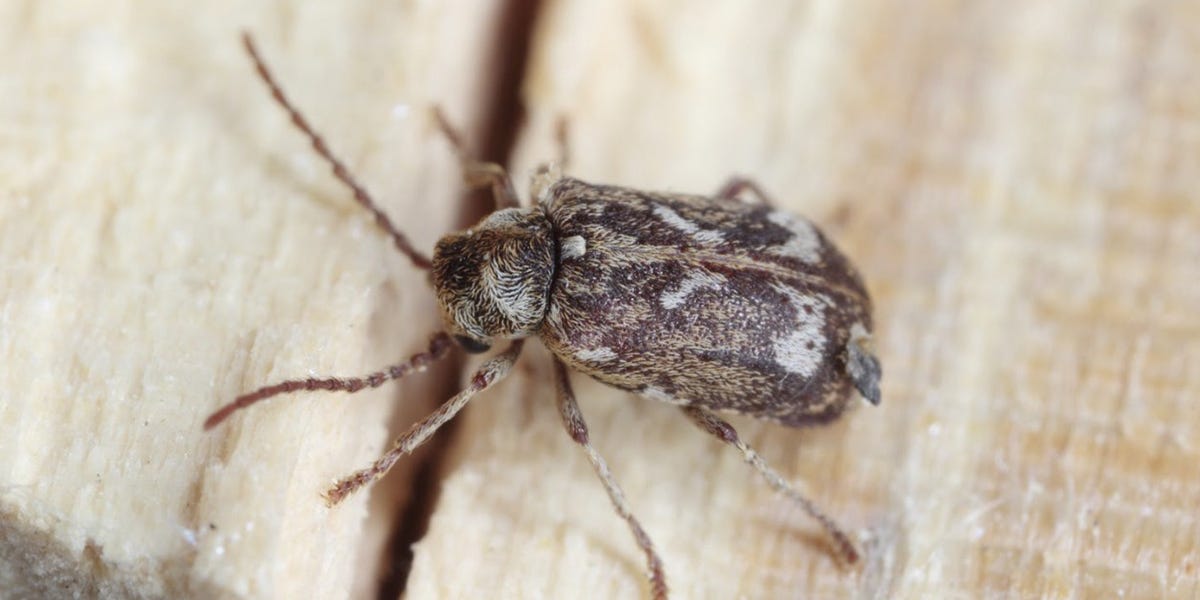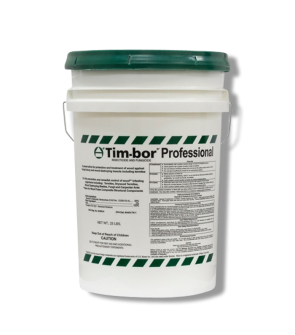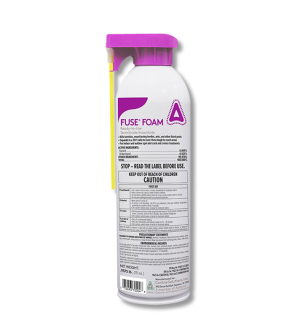Deathwatch Beetle Control
Most Effective Products
Deathwatch Beetle Control: How to Get Rid of Deathwatch Beetles
This page is a general DIY guide on getting rid of deathwatch beetles from your property by using the products and methods suggested by our professional pest control specialist. Follow this guide and use the recommended products and we guarantee 100% control of deathwatch beetles.
Homeowners might have heard a light tapping or ticking sound coming from within the walls or rafters of their home during quiet summer nights. One of the pests most associated with this night activity is the deathwatch beetle, also called the anobiid beetle. These destructive pests were associated with the name from individuals watching the dead and dying often referring to the deathwatch beetle mating call as an omen to approaching death.
While this a myth the sound does pose an alarm for any homeowners possessing old structural wooden beams in their homes or structures. The larvae stage of this wood boring beetle does most of the damage to the wood with its vigorous feeding activities causing structures to become weaken.
Unfortunately, larvae is not normally seen and their activities go unnoticed because they can take from 4 to 12 years to complete their growth then move towards the surface of the wood in its pupae stage. The adult deathwatch beetle then tunnels its way out in spring or early summer leaving behind a round exit hole. For this reason, you will need to quickly implement the use of the following recommend products and tips at the first sign of deathwatch beetle activity.
Identification

Before proceeding with treatment, you will need to be sure the wood infesting pest is a deathwatch beetle. Careless identification can lead you to using the wrong or ineffective insecticides, which can be a waste of your time and finances. Here are some identifying features of deathwatch beetles to know what they look like:
- Deathwatch beetles are medium sized wood boring beetles that range between 1 to 9 mm long in length.
- In their adult form they have a cylindrical shaped body with a dark brown or red coloration and yellow scales on the wings. Head is not easily visible from above as its hidden below the thorax.
- Eggs are white, slightly pointed and may be laid in clusters within dark wooden crevices and tunnels left behind by previous larvae.
- Larvae are not normally seen as they spend their entire lives in the tunnels within wood. They are creamy white, and curved in a c-shape with six legs.
Use the image and description above to help you properly identify deathwatch beetles on your property and structures. If unsure, then contact us with either a photo or sample of the pest in a sealable plastic container by phone, email, or in-person at one of our store locations. This way we can properly identify your pest and recommend a professional treatment control plan for the pest you are encountering.
Inspection

Once you have confirmed deathwatch beetles on your property or home, you can then proceed with inspection. During this phase you are determining the areas where deathwatch beetles are most active to learn where to apply the insecticide and to remove the conditions allowing the pest to thrive.
Where to Look
Deathwatch beetles prefer to feed on soft, decaying, or moist wood including girders, beams, foundation timbers, wooden furniture, and hardwood floors, which is normally seen in old buildings or homes. Outdoors, this can be seen in dead wood, old trees, and older wooden structures on your property.
What to Look For
Much like termites, deathwatch beetles larvae consume the wood they inhabit until they mature into winged adults. Unlike termites, their damages are evident on the surface of the infested wood, but only after deathwatch beetles are no longer active.
Once the deathwatch beetle matures they carve out small 2 to 3 mm holes that are about 0.1 inch in diameter on the surface of the damaged wood in order to take flight and search for a mate. However, every year the deathwatch beetle returns to the same structure or wooden objects previously infested to lay their eggs.
If there are numerous holes then this may be indicative of a larger infestation.
Treatment
When beginning any form of pest control, you will need to wear the proper personal protective equipment (PPE) when handling and applying pesticides.
Control of deathwatch beetles involves applying a non-repellent insecticide as an injection treatment then treating the surfaces of exposed wood with a residual insecticide. If infestations are extensive then you may need to replace severely damaged wood and eliminate the conditions causing the wood to become soft and moist.
However, it can take several years for full control of deathwatch beetles and their larvae as they can live in wood for up to 13 years. These pests do not always emerge to contact the insecticide being used so applications are best done in May against deathwatch beetle eggs and their larvae.
Step 1: Insecticide Injection

Fuse Foam is a ready to use termiticide and insecticide foam that uses two non-repellent active ingredients fipronil 0.005% and 0.025% imidacloprid for direct injection into labeled structures to treat wood destroying insects like deathwatch beetles. When sprayed this aerosol product expands to a ratio of 30:1 to treat deathwatch beetles in hard to reach areas and as a non-repellent it goes undetected by pests without pushing them further into the wood.
While Fuse Foam is efficient on its own you may need to drill holes with a drill to access deathwatch beetles harborages. Be sure to wear the proper personal protective equipment (PPE) such as gloves before handling or applying Fuse Foam.
Simply shake the Fuse Foam can then insert the actuator straw or hose and spray tip into crevice, crack, wall voids, or hole. Slowly press the trigger for about 5 seconds to allow the foam enough time to expand and dispense. After applying this product, hold the injector tip in place for approximately 8 seconds after releasing the trigger.
Wait until 30 days has passed after the last application before treating previously infested areas.
Do not apply this product in the open or on exposed surfaces, or in areas accessible to children. Nor apply this product, by any application method, to certain types of wood, including: linden, basswood, or other Tilia species.
Step 2: Apply Residual Insecticide

Once all infested holes and voids have been treated, you will then apply a residual insecticide to eliminate emerging deathwatch beetles. Tim-Bor Professional Insecticide is a 98% disodium octaborate tetrahydrate (inorganic borate salt) based insecticide, termiticide, and fungicide product that penetrates the bare wood. Once applied this product remains in the wood eliminating the need for continuous reapplications and provides preventative and residual control of deathwatch beetles.
For a remedial treatment of deathwatch beetles, make 2 applications of Tim-Bor Professional Insecticide at a 10% liquid solution. To do this, use 5 gallons of liquid solution per 1,000 sq. ft. of wood surface area.
To use Tim-Bor Professional Insecticide, you will first need to mix the product in a bucket with a paddle mixer. Pour the required amount of hot water into the bucket then add the measured amount of Tim-Bor Professional Insecticide. Once everything has been added to the bucket connect the paddle mixer with the power drill and stir until it has the consistency of water. Next, pour the finished solution into your handheld sprayer tank.
Spray on a low-pressure setting until the raw or bare wood is wet, but not to the point of run-off. Wait until 48 hours has passed before applying paint, staining, or ceiling with a water-resistant product.
Apply the Tim-Bor Professional Insecticide only to bare wood, or plywood where an intact water-repellent barrier, such as paint, stain or sealer, is not present. Remove any previous finishes or water repellents before application of the Tim-Bor Professional Insecticide. Surfaces must be free of dirt and other contaminates.
Prevention

Once deathwatch beetles have been removed from your yard or structure, you will need to keep up with regular preventative practices since their larvae can take up to 13 years before they emerge from wooden surfaces. Listed below are some preventative practices you can follow to reduce deathwatch beetle presence within your yard or home:
- Keep moisture levels down in your structure since deathwatch beetle on wood with certain amounts of moisture. You can reduce these moisture levels by circulating your home with a fan, central ac system, or by installing a dehumidier.
- Inspect the wood around and inside of your home and replace as needed to avoid deathwatch beetle larvae. In addition, firewood stored outside of your home will need to have the bark removed before bringing it within your home to reduce further spread of these pests. Completely remove any fallen wooden debris and discarded construction wood from your property.
- Seal all wooden surfaces, cracks, and crevices around your home or inside the wood with caulk. Larger voids will need to be filled with Copper Mesh to avoid deathwatch beetles and other pests from coming into the interior framework of your home.
- Since most damages occur beneath the surface of your home it would be beneficial to replace previously infested wood with new lumber and then treat these bare or raw wooden surfaces with Tim-Bor Professional Insecticide. Use the 10% liquid solution for a preventative treatment of deathwatch beetles. Apply 5 gallon of liquid solution of Tim-Bor Professional Insecticide per 1,000 sq. ft.
Key Takeaways
What are Deathwatch Beetles?
- Deathwatch beetles are a type of wood-boring beetles that infests soft or moist ridden wooden parts of structures, floors, and trees. Their ability to burrow within these surfaces then not emerge until 13 years makes them a difficult pest to control.
How to Get Rid of Deathwatch Beetles
- To get rid of deathwatch beetles, you will want to use a non-repellent foaming insecticide such as Fuse Foam to any present cracks, crevices, wall voids, or holes to eliminate present pests. Next, you will apply a residual insecticide like Tim-Bor Professional Insecticide to control and repel emerging deathwatch beetles.
Preventing Deathwatch Beetle Reinfestation
- Prevent deathwatch beetles from revisiting your property by continually replacing decaying or soft wooden structures within your home, removing soft and moist trees, controlling the moisture levels within the home, and making a preventative treatment with Tim-Bor Professional Insecticide on bare wooden surfaces.














































































































































































































































































































































































































































































































































